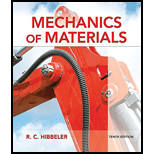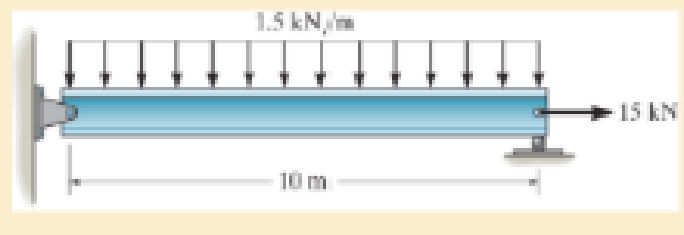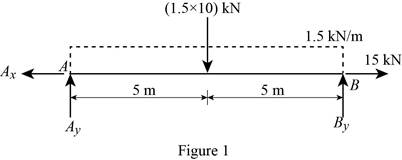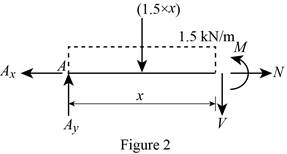
Concept explainers
A = 2300 mm2, I = 9.5(106) mm4.

R14–1
Answer to Problem 14.1RP
The total axial and bending strain energy in the A992 steel beam is
Explanation of Solution
Given information:
The cross-sectional area of the beam is
Moment of inertia of the beam is
Assumption:
The modulus of elasticity or Young’s modulus of theA992 steelis
Explanation:
Determine the reactions:
Entire beam:
Show the free body diagram of the entire beam as in Figure 1.

Moment about the point A:
Determine the vertical reaction at point B by taking moment about point A.
Along the vertical direction:
Determine the vertical reaction at point B by resolving the vertical component of forces.
Along the horizontal direction:
Determine the horizontal reaction at point A by resolving the horizontal component of force.
Show the calculation of reaction as follows:
Solve Equation (1).
Substitute 7.5kN for
Solve Equation (3).
Region
Show the free-body diagram of the section as in Figure 2.

Moment about the section:
Determine the moment at section by taking moment about the section.
Along the horizontal direction:
Determine the normal axial force at the section by resolving the horizontal component of forces.
Show the calculation of values as follows:
Substitute 7.5kN for
Substitute 15 kN for
Strain energy due to axial load:
Determine the strain energy of a bar of constant cross-sectional area A and constant internal axial load N using the equation.
Here, N is the axial load, L is the length of beam, E is Young’s modulus or modulus of elasticity, and A is cross-sectional area of the beam.
Substitute 15 kN for N, 10 m for L,
Strain energy due to Bending:
Determine the strain energy in the beam due to bending using the equation.
Here, M is the moment in the beam and I is the moment of inertia of the beam.
Substitute 10 m for L,
Total strain energy:
Determine the total strain energy by adding the strain energy due to axial load and the strain energy due to bending.
Substitute 2.4456 J for
Thus, the total axial and bending strain energy in the A992 steel beam is
Want to see more full solutions like this?
Chapter 14 Solutions
Mechanics of Materials (10th Edition)
Additional Engineering Textbook Solutions
Management Information Systems: Managing The Digital Firm (16th Edition)
Database Concepts (8th Edition)
BASIC BIOMECHANICS
Java: An Introduction to Problem Solving and Programming (8th Edition)
Elementary Surveying: An Introduction To Geomatics (15th Edition)
Electric Circuits. (11th Edition)
- 42 VOLTE 4G+ EV Suggested Que... Problem: You and your team are tasked with designing an around-coil system for an air- conditioning unit that will be installed in a hospital. The system must provide a controlled environment for the hospital's air-conditioning needs, ensuring that fresh air is brought in while exhaust air is expelled, without allowing contamination between the two airflow directions. The air-conditioning system will include two coils and two pumps (one duty pump and one standby pump) in a configuration that accommodates both exhaust and supply airflows. The system needs to comply with ASHRAE Standards, and ASME BPVC Section VIII, with attention to safety, reliability, and efficiency. The system will be used in a climate with moderate temperature variations, and its design will need to consider a range of operating and design specifications. Given data Desired Pressure in the Pipe: According to the (ASHRAE) standard for pressure drop limits. Pipe Diameter: Must comply…arrow_forwardcompute the work done by a fuel-water interaction assuming that the 40,000 kg of mixed oxide fuel and 4000 kg of water expand independently and isentropically to 1 atmosphere. Assume that the initial fuel and water conditions are such that equilibrium mixture temperature achieved is 1945 K. Other water conditions are as follows: Tinitial = 400K, ro initial = 945 kg/m^3, cv = 4184 J/kg-K. Caution: Equation 6.9 is inappropriate for these conditions since the cooland at state e is supercritial.arrow_forwardIf the W12x50 beam below is made of steel having an allowable bending stress of 36 ksi and an allowable shear stress of 15 ksi, determine the maximum cable force, P, that can safely be supported by the beam.arrow_forward
- This is a tilt and rotation question. Here are notes attached for reference. I prefer handwritten solutions. ONLY UPLOAD A SOLUTION IF YOU ARE SURE ABOUT THE ANSWER PLEASE. I prefer handwritten solutions.(If you had once answered this question don't answer it as I am looking for a different solution)arrow_forward3- Find the optimum of y = 9x - 0.1x ^ 2 in the interval 0 <= x <= 100 and alpha = 0.05 Use two and three experiments sequential search methods?arrow_forward1- A manufacturing company is optimizing the cooling time of a newly developed plastic molding process. The goal is to minimize the total production cost, which depends on the cooling time (t) in minutes. The production cost (C, in dollars) is given by: C=50+10(t)-0.5(t)^2 where: 5 st≤ 20 (cooling time in minutes) Using the Two-Experiments Sequential Method (up to five cycles) find the optimal cooling time (t) that minimizes the production cost. 3:29 مarrow_forward
- 2- Find the optimum minimum point of y = x²-6x + 2 in the interval 0 ≤ x ≤ 10 using sequential search method with three experiments. the accuracy a = 0.06. 3- Find the optimum of y = 9x -0.1 x² in the interval 0 ≤ x ≤ 100, and α = 0.05 Use two and three experiments sequential search methods?arrow_forwardhand-written solutions only pleasearrow_forwardhand-written solutions only pleasearrow_forward
 Elements Of ElectromagneticsMechanical EngineeringISBN:9780190698614Author:Sadiku, Matthew N. O.Publisher:Oxford University Press
Elements Of ElectromagneticsMechanical EngineeringISBN:9780190698614Author:Sadiku, Matthew N. O.Publisher:Oxford University Press Mechanics of Materials (10th Edition)Mechanical EngineeringISBN:9780134319650Author:Russell C. HibbelerPublisher:PEARSON
Mechanics of Materials (10th Edition)Mechanical EngineeringISBN:9780134319650Author:Russell C. HibbelerPublisher:PEARSON Thermodynamics: An Engineering ApproachMechanical EngineeringISBN:9781259822674Author:Yunus A. Cengel Dr., Michael A. BolesPublisher:McGraw-Hill Education
Thermodynamics: An Engineering ApproachMechanical EngineeringISBN:9781259822674Author:Yunus A. Cengel Dr., Michael A. BolesPublisher:McGraw-Hill Education Control Systems EngineeringMechanical EngineeringISBN:9781118170519Author:Norman S. NisePublisher:WILEY
Control Systems EngineeringMechanical EngineeringISBN:9781118170519Author:Norman S. NisePublisher:WILEY Mechanics of Materials (MindTap Course List)Mechanical EngineeringISBN:9781337093347Author:Barry J. Goodno, James M. GerePublisher:Cengage Learning
Mechanics of Materials (MindTap Course List)Mechanical EngineeringISBN:9781337093347Author:Barry J. Goodno, James M. GerePublisher:Cengage Learning Engineering Mechanics: StaticsMechanical EngineeringISBN:9781118807330Author:James L. Meriam, L. G. Kraige, J. N. BoltonPublisher:WILEY
Engineering Mechanics: StaticsMechanical EngineeringISBN:9781118807330Author:James L. Meriam, L. G. Kraige, J. N. BoltonPublisher:WILEY





